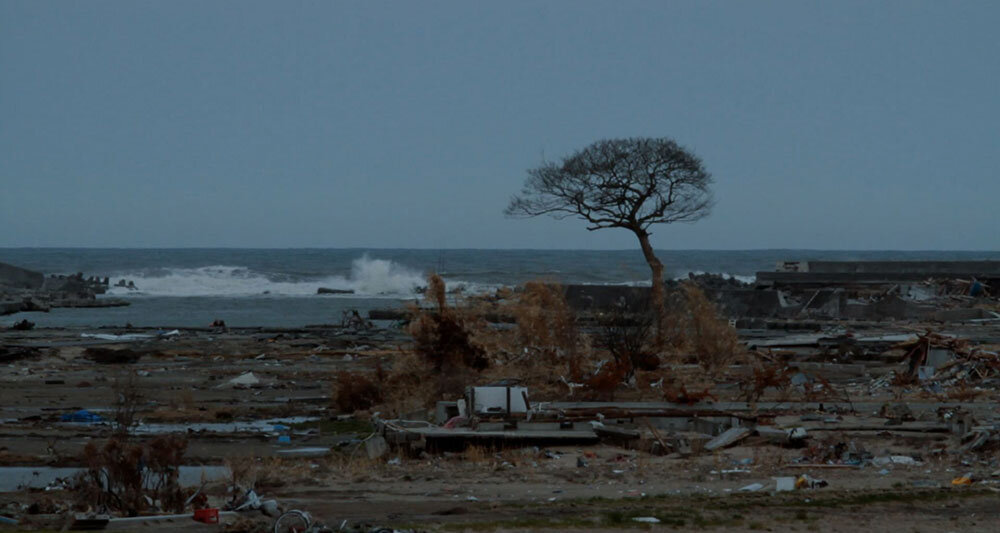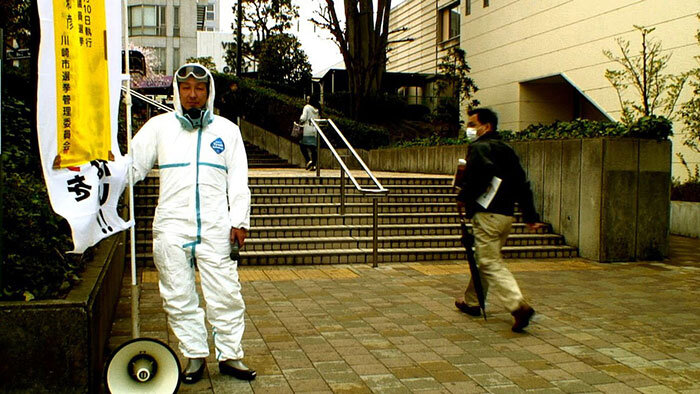3/11 Cinema
Originally published in Senses of Cinema Issue 92 (October 2019) for a special dossier themed ‘This is What Defined Cinema in the 2010s’.
The multifaceted disaster which struck Japan’s northeastern Tōhoku region on 11 March 2011 – a magnitude-9 earthquake, which triggered a devastating tsunami then the worst nuclear crisis since Chernobyl – resulted in over 22,000 people dead or missing. Close to half a million others were displaced as they fled the immediate destruction or the subsequent threat of radiation, or were otherwise forced to abandon their homes and maintain their livelihoods elsewhere.
Meanwhile, documentary filmmakers packed their bags and traveled in the opposite direction, flocking to affected areas to investigate, memorialise and ruminate on the disaster. They revealed its immense scope and honed in on smaller stories within it: a ground-level view of communities destroyed by the tsunami, in Koichi Omiya’s The Sketch of Mujo (Mujō Sobyō, 2011); the lives of refugees sheltering in an abandoned high school, in Atsushi Funahashi’s Nuclear Nation (Futaba kara Tōku Hanarete, 2012); an ancient festival which continued to be held inside the radioactive exclusion zone, in Yoju Matsubayashi’s The Horses of Fukushima (Matsuri no Uma, 2013). Some filmmakers kept returning. Ryusuke Hamaguchi and Ko Sakai co-directed a trilogy of documentaries (2012–2014) in which they listened patiently to the accounts of survivors. Masanori Iwasaki released a film at a rate of one per year for his series about animals abandoned by the disaster, Fukushima: A Record of Living Things (2013–17).
Sion Sono’s The Land of Hope (Kibō no Kuni, 2012)
Sion Sono was the unlikely candidate to get the ball rolling for fiction filmmakers, revising the screenplay for Himizu (2011) to incorporate the disaster as both setting and backstory. Next he made The Land of Hope (Kibō no Kuni, 2012), the first narrative feature to focus squarely on the nuclear fallout, then later the minimalist sci-fi The Whispering Star (Hisohiso Boshi, 2015), which turned the devastated coastlines into mournful, abandoned planets of a parallel galaxy. Others followed in Sono’s footsteps, but fiction filmmakers were, on the whole, slow to respond to 3/11 – a combination of apprehension about fictionalising the disaster, political nervousness, and inflexible production processes which would’ve slowed them down regardless. Foreign filmmakers who were unencumbered by domestic pressures, however, turned their eyes to Japan with a newfound inquisitiveness. In addition to a host of documentaries and quasi-journalistic works, the anthology film 3.11 Sense of Home (2011), Kim Ki-duk’s eco-thriller Stop (Seu-top, 2015), and Doris Dörrie’s intercultural drama Fukushima, mon Amour (Grüsse aus Fukushima, 2016) were just some of the films to be produced. And hot on the heels of HBO’s miniseries Chernobyl (2019) – which arguably wouldn’t exist had 3/11 not thrust fears about nuclear energy back into the global consciousness – a big-budget Japanese film equivalent, Fukushima 50, was recently announced for production.
Doris Dörrie’s Fukushima, mon Amour (Grüsse aus Fukushima, 2016)
Many regarded the influx of films and filmmakers with cynicism, and understandably so. Those who previously hadn’t so much as stepped foot in the Tōhoku region headed there in search of a film, then left once they got what they needed. Some films clumsily crowbarred 3/11 themes into their fictional narratives, while others rehashed films which had already been accused of doing the same thing. The sheer quantity of documentaries in particular, and the haste with which they were made, often reeked of carelessness or opportunism. One of the first documentaries to cover the disaster, Tatsuya Mori’s 311 (2011), drew furious responses from audiences and locals for its intrusive approach to filming the victims. The Yamagata International Documentary Film Festival screened a staggering twenty-nine films about 3/11 merely seven months after it occurred, and within a couple of years the market was awash with works by seasoned auteurs and amateur filmmakers alike. It also didn’t help that some filmmakers seemed to boast about the veracity of their films and presented the shooting conditions as some sort of Herzogian challenge. “We lived there. We shot there. We never left the [exclusion] zone through the entire shoot,” explained Dörrie on the making of Fukushima, mon Amour. “Everything is the real thing. Our main location is 11km away from Daiichi, the nuclear power plant.”[1]
Questions of ethics aside, the desire of filmmakers to try and make sense of Japan’s biggest calamity since World War II was mostly genuine. Some held deep personal connections to the Tōhoku region, and many of the films addressed urgent gaps in media and political discourses surrounding the disaster. The quantity and variety of films to come out of 3/11 also made logical sense: filmmakers were drawn to it because its impact on the nation was so pervasive and could be explored from a vast number of angles. Moreover, 3/11 was readymade for cinema, tapping into potent historical events, sociopolitical issues and cultural anxieties, as well as a plethora of themes, genres and filmmaking traditions. Footage of the initial earthquake and tsunami recalled (and indeed far exceeded) the destructive imagery from disaster films, kaiju films and other apocalyptic blockbusters – popular genres which are always locked in a reciprocal relationship with real-world calamities. The areas which were abandoned due to radiation resembled the empty landscapes of countless post-apocalyptic narratives, while the devastated towns and cities were reminiscent of those destroyed by wars of the past century. Filmmakers who visited and built a fiction around these locations mirrored the actions of those who did likewise in previous war and disaster zones (for example, Roberto Rossellini in Berlin after World War II, or Abbas Kiarostami in the Gilan Province following the 1990 Manjil-Rudbar earthquake). Documentary filmmakers, on the other hand, simply did what they’ve always done, which is to go where the stories are.
Kazuhiro Soda’s Campaign 2 (Senkyo 2, 2013)
The wide-ranging fallout from the Fukushima nuclear crisis, which is distinct from the rest of the disaster as being a direct consequence of human choices, was also reflected on screen. Films which engaged with this politically-sensitive topic – from The Land of Hope to Kazuhiro Soda’s Campaign 2 (Senkyo 2, 2013) and Nao Kubota’s Homeland (Ieji, 2014) – all dealt with the foreground issue of radiation and contamination, but also extended their focus (with varying degrees of directness and effectiveness) to themes of familial breakup, displacement, memory, psychological breakdown, political complacency, government incompetence and corporate cover-ups. Other films gauged the effects of the disaster on the national mood. The tremors felt hundreds of kilometres away in the nation’s capital reminded Tokyoites not only of past disasters which had virtually destroyed the city (namely the Great Kantō earthquake of 1923 and the American firebombings in 1945), but also of their precarious current situation as both inhabitants of a nuclear nation and of a city expecting its own mega-quake within the next generation. These apocalyptic anxieties have been expressed in Japanese literature and popular culture for years, and 3/11 renewed them. They were pronounced emphatically in Hideaki Anno and Shinji Higuchi’s Shin Godzilla (Shin Gojira, 2016), a memorable reboot of the franchise in which the titular monster re-emerged as an embodiment of the nuclear threat, and whose destruction of the capital evoked in no uncertain terms the natural disasters of 3/11. Significantly, this incarnation of Godzilla isn’t killed or repelled, but merely frozen; at the end of the film, it remains standing in the middle of Tokyo as a dormant reminder of the city’s potential devastation.
Hideaki Anno and Shinji Higuchi’s Shin Godzilla (Shin Gojira, 2016)
Eight years on, 3/11 has come to be addressed by a vast array of films and filmmakers, manifesting on screen as reportage, essays, drama, allegory, meditations, animation, science fiction and a kaiju blockbuster. For better and for worse, these films reinforced a longstanding relationship: cinema feeds off disaster and is crucial in helping us comprehend it. For postwar Japanese cinema, the shared national trauma of World War II has long been the central historical reference point, as integral to its themes and narratives as it has been to those of the nation itself. Even as many issues from the war remained unresolved, 3/11 refreshed this trauma, leaving behind in its wake new realities, aesthetic challenges and ethical responsibilities for filmmakers to confront. The visible traces of the disaster have already begun to fade, but its effects will continue to resonate in films for years to come – whether they’re shown, suggested, or felt only as an absence.
[1] Lee, Edmund. “Fukushima, Mon Amour is shot through with the shadow of Hiroshima.” South China Morning Post, 27 September 2016, https://www.scmp.com/culture/film-tv/article/2022636/fukushima-mon-amour-shot-through-shadow-hiroshima




